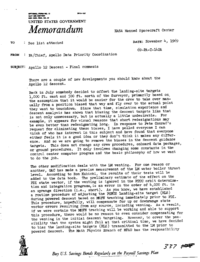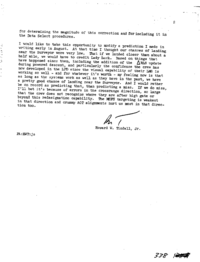See list attachedNovember 4, 196969-PA-T-142APA/Chief, Apollo Data Priority CoordinationApollo 12 Descent – Final comments
There are a couple of new developments you should know about the Apollo 12 descent.
Back in July somebody decided to offset the landing-site targets 1,000 ft. east and 500 ft. north of the Surveyor, primarily based on the assumption that it would be easier for the crew to take over man- ually from a position biased that way and fly over to the actual point they want to touchdown. Since that time, simulation experience and descent analysis has shown that biasing the descent targets like that is not only unnecessary, but is actually a little undesirable. For example, it appears for visual reasons that short redesignations may be even better than redesignating long. In response to Pete Conrad's request for eliminating these biases, I have polled everyone I can think of who has interest in this subject and have found that everyone either feels it is a good idea or they don't think it makes any differ- ence. And so we are going to remove the biases in the descent guidance targets. This does not change any crew procedures, onboard data packages, or ground procedures. It only involves changing some constants in the control center computer program and the basic philosophy of how we want to do the job.
The other modification deals with the LM venting. For one reason or another, GAC has made a precise measurement of the LM water boiler thrust level. According to Ron Kubicki, the results of their tests will be added to the data book. The preliminary estimate of the effect on the PDI state vector, if the venting is ignored in the RTCC orbit determina- tion and integration programs, is an error in the order of 4,000 ft. in an uprange direction (i.e., short). As you know, we have established a routine procedure of adjusting the PGNCS landing-site target (RLS) during powered descent based on MSFN tracking immediately prior to PDI. This procedure, hopefully, will compensate for up or downrange state vector errors resulting from any source, including venting. As a result, if we were certain the MSFN tracking will be working and able to support this procedure, there would be no reason to even consider compensating for the venting in the initial descent targeting. However, to cover the pos- sibility that the system might fail at that critical time, we have decided to bias the landing-site targets (RLS) transmitted to the LM prior to powered descent. The Math Physics Branch of MPAD has the responsibility for determining the magnitude of this correction and for including it in the Data Select procedures.
I would like to take this opportunity to modify a prediction I made in writing early in August. At that time I thought our chances of landing near the Surveyor were very low. That if we landed closer than about a half mile, we would have to credit Lady Luck. Based on things that have happened since then, including the addition of the ΔRLS update during powered descent, and particularly the confidence the crew has now developed in the LPD since the visual capability of their LMS is working so well – and for whatever it's worth – my feeling now is that as long as the systems work as well as they have in the past, we have a pretty good chance of landing near the Surveyor. And I would rather be on record as predicting that, than predicting a miss. If we do miss, I'll bet it's because of errors in the crossrange direction, so large that the crew does not recognize where they are after high gate or beyond this redesignation capability. The MSFN targeting is weakest in that direction and crummy AOT alignments hurt us most in that direc- tion too.
- Aug 01, 1969 – How to land next to a Surveyor – a short novel for do-it-yourselfers (6.7σ)
- Nov 09, 1967 – MIT/MSC review of LUMINARY Descent Programs (5.4σ)
- Sep 04, 1969 – Notice of a catch-all Apollo 12 Mission Techniques meeting (3.5σ)
- Dec 17, 1969 – Apollo 13 Mission Techniques are in good shape (3.3σ)


